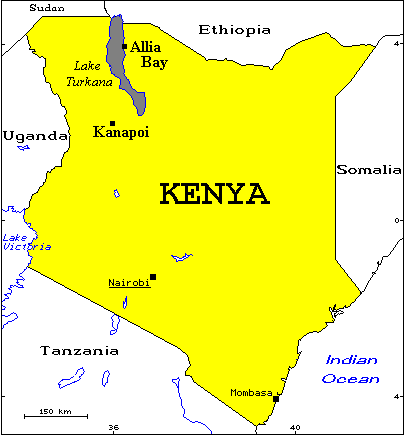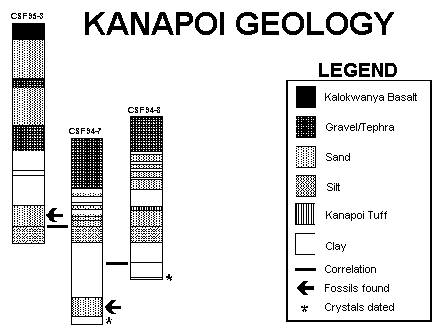|
|
Australopithecus anamensis |
|
|
|
Australopithecus anamensis |
|
by Laurence D Smart B.Sc.Agr., Dip.Ed., Grad.Dip.Ed
Email: laurence@unmaskingevolution.com
Webpage: www.unmaskingevolution.com
[Free to print and distribute. Copy must be in full.]
The Report to the Public
Source - Bulletin/Newsweek, 116(5985), p:65 1995
Headline - "Humankind's First Steps"
Major Heading - "With the unearthing of a very ancient ancestor, human evolution can now be traced back more than 4 million years through fossils."
Viz:-
Ardipithecus ramidus - 4.5 Myr
Australopithecus anamensis - 4.2 Myr
Australopithecus afarensis ('Lucy') - 3.5 Myr
Homo habilis - 2.0 Myr
Homo erectus - 1.0 Myr
Homo sapiens - 0.2 Myr
The Scientific Report
SOURCE: Nature, Vol. 376, p:565-571 1995
(1) No complete skeleton was found. The species is based on an analysis of 26 skeletal fragments, consisting of: - 1 head of a humerus; 2 heads of a tibia; 1 radius; 1 temporal bone; 1 complete mandible; 3 fragments of mandibles; 2 maxilla fragments; & 15 teeth. p:567
(2) The holotype is a complete mandible (KNM-KP 29281). It was found at Kanapoi in 1994.
(3) Part of a left temporal bone from a skull was included in the holotype. It was found near the jawbone but it may have come from another individual, which may have been another species. The discoverers assumed that it was "probably from the same individual". p:565
(4) Twelve fossil fragments found in Kanapoi (Kenya) in 1994 were included in the anamensis skeleton. Another fragment (KMN-KP271), the head of a humerus (arm bone), was actually found in 1965. Where was it found? What layer did it come from? We are not told.
(5) Thirteen other fragments that make up anamensis came from Allia Bay, approximately 150 Km away, on the edge of Lake Turkana (Kenya). One fragment was found in 1982, two in 1988, and the other ten in 1995.
(6) The specimens at Allia Bay were spread over a distance of 1Km.

(7) There is a great deal of variation in the jaws and teeth in the collection. This difference was stated to "probably be attributed to sexual dimorphism". No mention was made that the fragments could have come from other species. p:565
(8) The ear canal in the temporal bone looks like a chimpanzee's ear canal. Why couldn't the bone have come from a chimpanzee?
(9) The tibia (leg bone), KNM-KP29285, chosen to represent anamensis, was not found with the holotype.
(10) The biggest problem with the tibia is that it had the middle section missing. It may actually have been the parts of two separate tibias.
(11) The 2 tibia fragments were said to suggest that anamensis was bipedal (walked on two legs), even though a complete skeleton was not found to verify this hypothesis.
(12) This guessed bipedalism was altered to definite bipedalism in the conclusions of the report.
(13) The estimation of the weight of an anamensis individual was based on this incomplete tibia. It was calculated by comparing it with the anatomy of a human.
(14) It was stated that many features of the tibia "resembles African apes". However, the arm bone found (a humerus) was said to be "human-like." p:566
(15) This humerus was also used to estimate the individual's weight by comparison with human data.
(16) These skeletal parts, some ape-like & some human-like, were lumped together under the guise of mosaic evolution - "mosaic evolution appears common in the Hominidae". p:568
(17) The actual rocks in which the fossils were alleged to be found were not dated. Instead, crystals of feldspar were separated from layers of claystone ("probably former pumices") in the rock strata, and these were analysed. p:568
(18) The dates were also calculated using correlation. This means that the palaeontologists constructed a 'complete' geological column based on the probability that the layers on rock at different sites could be meshed accurately together. This included samples at great distance from the sites.

(19) The Ar-Ar method was used to date the rocks above and below the fossils. This method measures both 40Ar & 39Ar levels in rock crystals.
(20) The ages of the crystals were calibrated by comparing them with a sample of sanidine fluence monitor. The monitor consists of crystals of minerals separated from Fish Canyon Tuff, Colorado. The monitor crystals had been previously dated at 27.9 million years old using K/Ar dating. p:569
(21) K-Ar dating has been shown experimentally to be completely erroneous. Therefore, the dates for these Kanapoi rocks are just as erroneous because they were calculated by comparing them to a K-Ar date.
(22) The surface Kalokwanya basalt rock layer at Kanapoi, between 3 & 5 Km from the fossil sites, was dated at 3.11 & 3.41 million years old also using K-Ar dating. p:570
(23) Another sample of rock was analysed from a site about 1.3 Km from the fossils. This was used to calculate the age of the rocks ...
(24) The fossils from Allia Bay "derive from beneath or within the Moiti Tuff." p:571
(25) The age of the Moiti Tuff was calculated at 3.92 Myr by Ar-Ar dating. It was previously dated as 4.10 Myr using the K-Ar method. p:571
(26) The age of the fossils is justified using the K-Ar ages of the overlying basalt (the surface layer), rather than by measuring the ages of the many rock layers above them.
(27) The rock ages gave dates for the fossils of ~4.17 - >3.4 Myr old. Notice that they selected 3.4, and not 3.1 Myr, as the minimum age derived from the Basalt rocks. This was most likely done to make the age range fit into the older end of the ages for 'Lucy' (3.0-3.6 Myr).
(28) This range of ages was purposely narrowed using palaeogeographic evidence. This was to ensure that anamensis was definitely older than Lucy.
(29) The fossils were stated to vary in age from 3.5-4.1Myr (p:571). This large gap in evolutionary time could just as easily indicate that the bones were from different species.
(30) No discussion was produced in the report for the radius, and no analysis was made of it. This would have given more insight into the species. Why was it left out???
(31) Based on the assumption that all crystals in a rock layer are the same age, and contain the same amounts of radioactive Argon, samples which differed from the rest were excluded from the analysis. This is contrary to standard statistical principles for such small samples (n=9).
for example sample 95-36 +1.6% +70,000 yrs
sample 95-40 -3.1% -129,000 yrs
sample 95-38 +7.1% +292,000 yrs
sample 95-37 +3.1% +130,000 yrs
(32) Descriptions were given of the environments at the prehistoric sites when the fossils were formed. The writers of the report confessed that this was pure speculation, so we have confirmation that these descriptions are not factual.
SOME INTERESTING ENLIGHTENMENTS
![]()